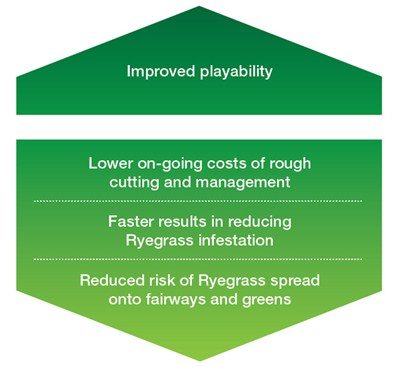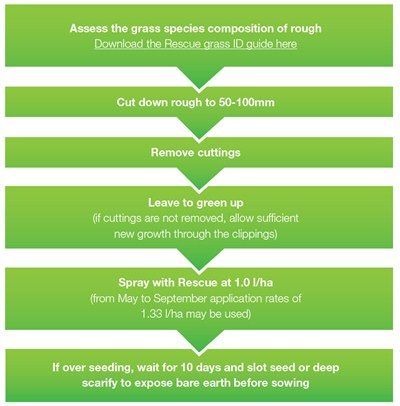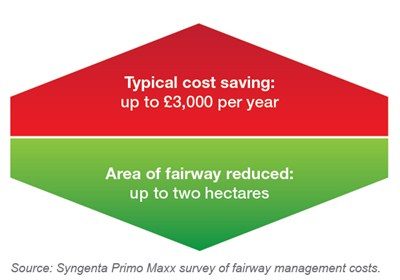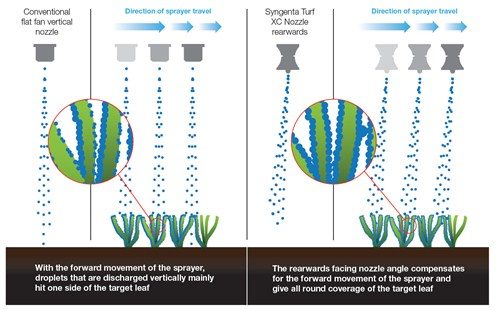
Thick rough has been the bane of every golfers' game this season. The incredibly wet conditions have encouraged excessive coarse grass growth and prevented mowing, which has resulted in almost unplayable conditions on many golf courses.
The Syngenta Golf Player Survey revealed that thick, coarse rough is the number one complaint among golfers. Over 50% of golfers were dissatisfied with the state of thick rough, with over 70% stating ease of ball location as a high priority. The drastic action, where coarse rough is causing slow rounds, lost balls and immense frustration has been to cut it all to the ground, leaving a prairie course of limited interest or challenge to golfers.

Player benefits of Fescue rough:
- Ball location is easier
- Wayward shots are penalised, but offer the golfer a recovery shot
- Play is faster; fewer hold ups with players in front looking for balls
- Hole design and approach is better defined
- The course is visually more attractive and challenging
The good news is that the wet, warm soils and vigorous growth are ideal conditions for Rescue herbicide treatment, to selectively remove ryegrass and create an open sward of fine Fescue grass species.
The Rough Rescue Programme

Over seeding advice
When over seeding dense rough with a high proportion of Ryegrass, it is preferable to wait until the ryegrass has started to die back, to reduce competition and open the sward that will allow new seedlings to establish.
Over sowing with Fescue species will create a faster transition to fine, wispy rough. Fescue dominated rough can be more effectively managed, with lighter annual cutting and less trimmings to remove - further reducing the fertility and creating a more sustainable, low-cost sward. If Ryegrass does begin to re-infest the sward, it can be quickly and easily removed with Rescue in spring or autumn.
Fairway sculpting and cost saving
Allowing well-managed thin, wispy Fescue rough to encroach by an average of just 1.75m on either side of the fairways on a typical 18-hole, 7000-yard course, could reduce the total fairway and managed mown area by over two hectares.
This easily playable rough can enable holes to be sculpted more effectively, to reward accurate play and enhance the visual appeal of the course, without excessively penalising wayward shots or slowing up play.

Furthermore, with a recent survey revealing the average fairway mowing costs for golf clubs of over £20,500 a year, a two-hectare reduction could typically save clubs up to £3000 a year, as well as releasing valuable time for other essential maintenance work that will enhance the playing experience.
Spraying rough
Remember that if you are spraying deep rough you may need to raise the boom height of the sprayer to maintain even coverage on taller leaves. The optimum is to spray at 50cm nozzle height above the spray target zone.
As a general rule, it is better to err on the higher side, than risk spraying at too low a height when the spray pattern may not be complete; when spraying rough drift is typically less of an issue, compared to greens or fairways, as the open canopy structure effectively draws the spray down.
Additionally, using the angled Syngenta Turf Nozzle with a rearwards facing spray pattern will counteract the forwards movement of the sprayer and deliver better all-round coverage of tall vertical leaves, compared to standard vertical flat fan nozzle.

Also, as you are targeting a foliar application and using a systemic herbicide active that will be drawn down into the plant, the key is to retain as much spray on the leaf surface as possible. Spraying in the minimum water volume of 250 l/ha will reduce the risk of over wetting leaves and optimise retention, whilst increasing sprayer output per fill.
Engaging player support
If you are seeking Club and player support for investment in managing the rough, now is the opportune time to engage their attention.
The GreenCast website has a range of communication tools to aide communication with Club management and players on the role of Rescue in enhancing playing surface quality, as well as the on-going process and what they will see.
Click here to view the Rescue resources available on GreenCast
Putting the programme into practice
In Ireland leading turf agronomist, Eddie Connaughton, is putting the Rescue Programme into practice to recreate the desired links rough appeal:
"The use of the integrated management programme of cultural and herbicide treatments will remove the Ryegrass and Yorkshire fog from the unmaintained rough and allow the native fescues to regenerate to a dominant position once again. The potential of this integrated management system is to create a wispy fescue dominated rough where a ball can be found without annoyance and irritation, as deemed so important by Dr. Alister Mackenzie."
Read a full report of Eddie's experience and advice here
Establishing wildflowers
Trials by the STRI have also shown that Rescue removal of ryegrass can play an important role in helping to successfully establish wildflowers in areas out-of-play rough as part of the Operation Pollinator initiative - creating essential habitat for important pollinating insects and an interesting area of attractive visual enhancement for players on the course.
The techniques developed by STRI include Rescue treatment in areas where ryegrass is dominant, followed by deep scarification to expose up to 60% bare earth, before broadcast distribution of wildflower seed onto the surface. The seed should not be buried. The trials have also shown that where remaining grass growth is strong, application of Primo Maxx to supress competition can enable stronger establishment of new seedlings.
Click here for more on the establishment of wildflowers

- Cut and remove thick rough to reduce fertility
- Avoid spreading fertiliser on rough areas
- Treat with Rescue whilst target species are actively growing
- Over seed with Fescue species
- Continue integrated cutting and Rescue treatments to establish Fescue dominance
